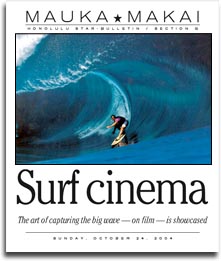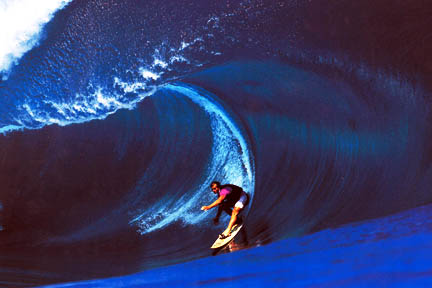

 MAKAI ]
MAKAI ]

|
Big waves, big screen
"Endless Summer" filmmaker
Bruce Brown talks about
the movie that changed
the sport
MORE than four decades ago, I was a kook -- a beginning surfer -- who lived in Hollywood and had to hitchhike 16 miles -- board in tow -- to get to a usually blown-out or flat Santa Monica beach.
Surf CinemaShowing at Dole Cannery cineplex:"Ishmael": What drives a surfer to the Atlantic Ocean during New England's coldest winter in 20 years? 9:45 p.m. today. Preceded by "Pororoca: Surfing the Amazon." "Riding Giants": The history of surfing, from ancient Hawaii to big-money modern days; 8:15 p.m.
Surf Film Talk StorySeminar: 1 p.m. todayPlace: Doris Duke Theatre, Honolulu Academy of Arts, 900 S. Beretania St.
|
I begged the manager to let me and two surfing buddies attend. He agreed, but we'd have to sit in the front row.
We wore our best surfing togs: light blue Levi cords, Pendleton shirts, Converse sneakers. The surf stars of the film, Mike Hynson and Robert August, and others such as big-wave legend Greg Noll, the mischievous Dewey Weber, even Mickey "Da Cat" Dora, all arrived in tuxedoes.
In the front row, we craned our necks, eyes wide in awe as we digested the most famous surfing film ever made. "Endless Summer" would make Hollywood sit up and take notice that surf films did not have to be "Beach Blanket Bingo" to attract viewers.
The film also prompted surfers to explore the globe for new spots and encouraged a whole generation to take up the sport of the Hawaiian alii.
When I tease Bruce Brown that he likely is the one responsible for today's crowded surfing conditions, he laughs.
"A lot of people try to make me feel guilty about that, and while I'm sure 'Endless Summer' hurried it up, the sport was growing by leaps and bounds simply because it's so much fun," he said in a telephone conversation from his Santa Barbara County home. "No one could have stopped it."
Brown was slated to attend today's "Surf Film Talk Story" seminar, but he had to cancel after breaking some ribs in August. Filmmaker panelists will include Jack Johnson, the Malloy brothers and Don King.

|
Though Brown wasn't the first surf filmmaker -- that honor goes to Bud Browne and Greg Noll -- he remains best known.
"The whole thing just happened," Brown says. "I never planned it this way."
Brown's reason for becoming a surf photographer was pragmatic: "I had a wife and family on the way. But I loved showing something that is so much fun and naturally beautiful."
The hardest part was making himself stay on the beach to film, as long as the waves cooperated. "I felt obligated to do the best I could," he said. "I figured if you were charging people a dollar, you'd better do your job."
When Brown started surfing in the early 1950s, he would take still photos to show his mother what the sport was about. Later, while stationed in the Navy on Oahu, he used an 8 mm movie camera to photograph surfing nomads from California.
"When I got back to California, I edited the thing into an hour-long movie, and (surfer) Dale Velzy would show the film at his San Clemente shop," Brown said. "We'd charge 25 cents."
Velzy bought Brown a 16 mm camera, and the pair came up with $5,000 to make Brown's first "real" surf film, "Slippery When Wet," in 1958.

|
Brown, 67, was born in San Francisco, grew up in Southern California and attended school in Long Beach before moving south to Dana Point. In the winter of 1958, Brown returned to Hawaii to film the big surf on the North Shore.
"I got on the plane with a book about how to make movies," he said. "I never had formal training in filmmaking, and that probably worked to my advantage.
"We probably did a lot of things that were pretty unconventional. I doubt I would have taken the same approach had I gone to film school."
In the back of his mind, Brown wanted to make enough money to go to film school, although he had already made five surf films. Then he got a call to talk to students at the University of Southern California film school.
"After talking to them I thought, 'Thank God I didn't go to film school, because I would have thought I could never have done what I did for the last five years.'"
In those early days, the surf filmmaker would narrate his movies live. "We couldn't afford a soundtrack," Brown said. "But it worked well because every time you did it, you could perfect the narration. It was really good training."

|
Brown's 1962 "Waterlogged" was billed as "the best waves and riders from four years of globe-spanning surf photography."
"By 1962, I'd spent five years full time making surf films, one per year," Brown said. "I'd shoot during the fall and winter, edit during the spring and show the complete film during the summer.
"There was never enough time. I felt if I could take two years to make a film, maybe I could make something special."
But something special would cost more money to produce than all his other films had grossed. To allow himself the extra time and money, he took the best 90 minutes from his four previous films and made "Waterlogged."
"That gave us the freedom to make our special film." The result was "Endless Summer," which cost $50,000 and grossed more than $20 million.
The editing process in those days also was a bit rustic. "We would take the films to the venues in a van, and we had rewinds and viewers in the back of the van and I would actually edit the stuff while we were traveling. I would adjust it according to the reactions of the audience from the previous night."
That experience served Brown well when he moved from basically home movies of surfing into the Hollywood realm with "Endless Summer."
Brown was rejected by several studio distributors because executives didn't believe the film would attract an audience "five miles from the ocean." So the filmmaker gave "Endless Summer" the ultimate test.
"We went to Wichita, Kan., in January," he said. "It showed for two weeks and sold out its entire run, breaking the record of 'My Fair Lady.'"
The distributors thought it was a fluke, so Brown rented a theater in New York City, where his film played successfully for a year.

|
Distributors came around but wanted to change aspects of the film and its marketing. "One group said the poster's no good, and others said we need more chicks in it," Brown said. "I think an 'Endless Summer' original poster is going for $10,000 on eBay."
Brown says surfing photography today is easier because of advances in camera technology and because the surfing is better. But there are not many more places to discover.
"I categorize films and videos as two different things," he said. "A lot of the stuff today doesn't have enough story, but are just sequences clipped together."
Brown rarely takes pictures these days, still or video. He surfs occasionally.
"I got a new video camera, but I shot like three things and that was it," he said. "I kinda lost interest."
Still, there are moments of his filmmaking past that surprise him. "Sometimes when I'm sitting out in the lineup, somebody will paddle up to me and vividly recall parts from my old movies: Phil Edwards surfing in his flowered trunks; Pat Curren, Byron Kough and Peter Cole riding Waimea; Jose Angel doing a barrel roll without his board at sunset; Del Cannon diving off Waimea Falls," Brown says. "A lot of the things they remember and I don't.
"Are you sure that was in one of my films?"
"Yeah! Hey, I saw 'Waterlogged' seven times!"
"It's neat these people have fond memories from my old films. It gives me a lot of pleasure and makes me grateful to be part of our sport."

|

Click for online
calendars and events.